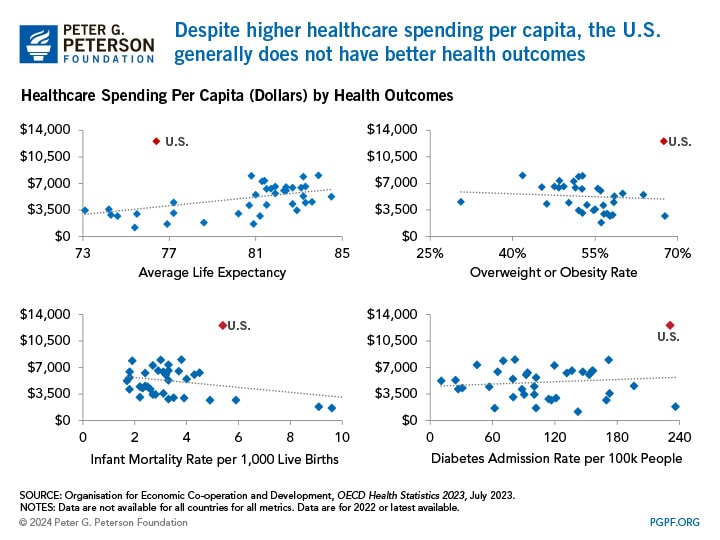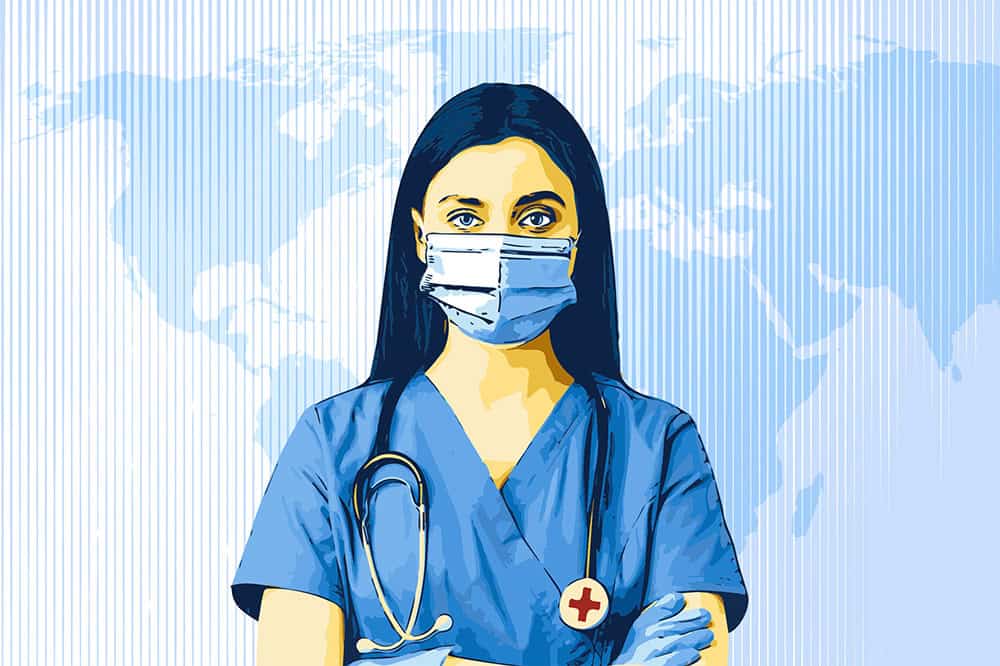The United States spends significantly more on healthcare compared to other nations but does not have better healthcare outcomes. What’s more, rising healthcare spending is a key driver of America’s unsustainable national debt, and high healthcare costs also make it harder to respond to public health crises like the COVID-19 pandemic. Below is a look at the increasing healthcare costs in the United States, what is causing that rapid growth, and why it matters for public health and our fiscal outlook.
How Much Does the United States Spend on Healthcare?
The United States has one of the highest costs of healthcare in the world. In 2022, U.S. healthcare spending reached $4.5 trillion, which averages to $13,493 per person. By comparison, the average cost of healthcare per person in other wealthy countries is less than half as much. While the COVID-19 pandemic exacerbated the trend in rising healthcare costs, such spending has been increasing long before COVID-19 began. Relative to the size of the economy, healthcare costs have increased over the past few decades, from 5 percent of GDP in 1962 to 17 percent in 2022.
Why Has Healthcare Spending Risen in the United States?
Generally, healthcare spending can be thought of as a function of price (dollars charged for healthcare services) and utilization (the amount of services used). There are several underlying factors that can increase price and utilization, thereby boosting spending on healthcare. The most notable of those factors are an aging population and healthcare prices.
An Aging Population
The share of the U.S. population age 65 and over has increased over the past several years, rising from 14 percent in 2012 to 17 percent in 2022. Furthermore, that number is projected to continue climbing – reaching 21 percent by 2032. Since people age 65 and over, on average, spend more on healthcare than any other age group, growth in the number of older Americans is expected to increase total healthcare costs over time.
Furthermore, as individuals turn 65, they will become eligible for Medicare, and the number of enrollees in the program — 65 million in 2022 — will grow substantially. The increase in enrollment is expected to significantly increase the cost of Medicare over time. In fact, the Congressional Budget Office projects that Medicare spending will nearly double over the next 30 years relative to the size of the economy — growing from 3.1 percent of GDP in 2023 to 5.5 percent by 2053.
The Increasing Cost of Healthcare Services
Prices are another significant driver of healthcare spending in the United States; the cost of healthcare services typically grow faster than the cost of other goods and services in the economy. In the past 20 years, the Consumer Price Index for All Urban Consumers (CPI-U) for all items — the average change in prices paid by urban consumers for various goods and services — has grown at an average of 2.6 percent per year while the CPI-U for medical care has grown at an average rate of 3.1 percent per year. Over the past two years or so, however, the CPI-U for medical care has been lower than the overall CPI-U. In addition to historically high levels of overall inflation, analysts point to wage increases for health workers and delays in observable price increases, due to healthcare prices being set in advance, as possible reasons for that trend.
There are many possible reasons for that increase in healthcare prices:
- The introduction of new, innovative healthcare technology can lead to better, more expensive procedures and products.
- The complexity of the U.S. healthcare system can lead to administrative waste in the insurance and provider payment systems.
- The consolidation of hospitals can lead to a lack of competition or even a monopoly, granting providers the opportunity to increase prices.
More research needs to be done, though, to confirm the reasons that healthcare costs grow so quickly.
Why Increasing Healthcare Costs Matter
It would be one thing if high healthcare spending led to better health outcomes. However, that is not the case in the United States. When evaluating common health metrics, the United States lags behind other countries despite spending more on such goods and services.

Conclusion
High healthcare costs put pressure on an already strained fiscal situation and are one of the primary drivers of the long-term structural imbalance between spending and revenues that is built into the country’s budget. Containing high healthcare costs is important for our nation’s long-term fiscal and economic well-being. For ideas on how to solve some of these issues, visit our Solutions page and the Peterson Center on Healthcare.
Image credit: Photo by Chip Somodevilla/Getty Images
Further Reading
How Does Government Healthcare Spending Differ From Private Insurance?
Government insurance programs, such as Medicare and Medicaid, made up 45 percent, or $1.9 trillion, of national healthcare spending.
7 Key Facts About Rising Healthcare Spending in the U.S.
Healthcare spending in the United States is a key driver of the nation’s fiscal imbalance and has risen notably over the past few decades.
Infographic: U.S. Healthcare Spending
Improving our healthcare system to deliver better quality care at lower cost is critically important to our nation’s long-term economic and fiscal well-being.


